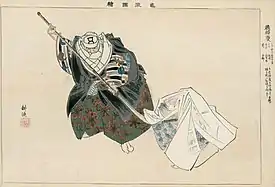Benkei on the Bridge
Benkei on the Bridge (橋弁慶, Hashi Benkei) is a Japanese Noh play from the 15th century, by Hiyoshi Sa-ami Yasukiyo.[1]

Benkei and Yoshitsune, in disguise, meet on Gojō Bridge, a scene from Hashi Benkei; woodblock print by Kōgyo Tsukioka from the series Nōgaku zue or Pictures of Noh Plays
Theme
The play centres around the encounter between the giant warrior monk Benkei and the youthful Minamoto no Yoshitsune, in which the slighter, younger man defeated the elder.[2] The hand-to-hand bridge combat forged a lasting bond between the pair.[3]
Thereafter Benkei served as Yoshitsune’s second in command[4] - as what Basho would describe as “his faithful retainer, Benkei”.[5]
Later developments
Buson created a haiku and a haiku painting, Benkei and Young Bull, around the themes of the play, quoting from it in his haiku:
“Snow, moon, and blossoms -
And then a pledge for three lives,
Faith and loyalty”.[6]
See also
Wikimedia Commons has media related to Hashi Benkei.
References
- A Waley, The Noh Plays of Japan (1976) p. 52
- L Zolbrod, Haiku Painting (Tokyo 1982) p. 12
- L Zolbrod, Haiku Painting (Tokyo 1982) p. 12
- H McAlpine, Japanese Tales and Legends (London 1960) p. 56
- Basho, The Narrow Road to the Deep North (Penguin 1983) p. 109
- L Zolbrod, Haiku Painting (Tokyo 1982) p. 12-13
External links
This article is issued from Wikipedia. The text is licensed under Creative Commons - Attribution - Sharealike. Additional terms may apply for the media files.